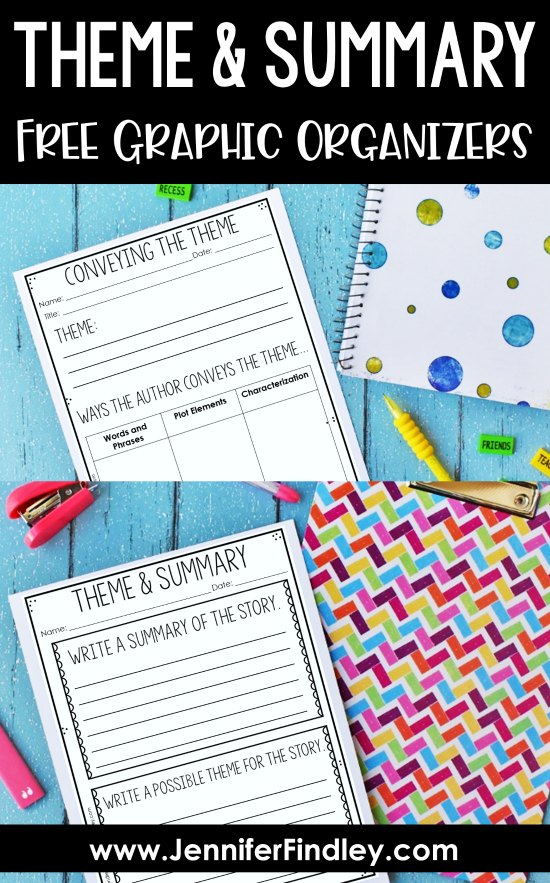When the common core standards first hit my state, I knew I needed to do some research and studying to fully understand the reading standards and how to teach them. One way that I did this was by joining a book club and reading Teaching with the Common Core Standards for ELA. This post will share some of my thoughts and a few free graphic organizers specific to teaching Key Ideas and Details Standard 2 (RL.3.2, RL.4.2, RL.5.2). This standard focuses on identifying theme and summarizing a text.
Click on the links below to check out my other posts in this “series”:
Teaching RL.1 Ideas and Free Graphic Organizers
Teaching RL.3 Ideas and Free Graphic Organizers

Here is the progression of the standard RL.3 throughout the grades (focusing on grades 3-5 only):
- 3rd graders have to recount a story and then determine the message, lesson, or moral.
- By 4th grade, the term changes to theme of a text and the students have to support the theme with details from the text. Also the term recount changes to summarize.
- 5th graders have do all of this AND explore how the characters react to challenges and contribute to the theme of the text.
Questions to Support Students Understanding:
The section on this standard spent a lot of time focusing on having the students explore how the details the author used contributed to the theme. Questions to ask would be:
- How does this phrase contribute to the theme of the story?
- How does the author’s choice of words help convey the message of the story?
- How does this specific event contribute to the theme of the story?
- How does the author develop the theme through the plot elements?
- How does the author develop the theme through the main character and the character’s dialogue and action?
- How does the summary of the story differ from the theme?
- How do summary and theme connect with another?
Activities for Teaching Theme and Summarizing:
- Read fairy tales or other engaging read alouds with clear themes as an introduction to the skill. Fairly tales typically have easily identifiable themes and are easier for the students to summarize. As an extension for the older grades, read twisted fairy tales from different points of view. These twisted fairy tales typically have different themes from the original. This leads to really good conversation about themes and how they are conveyed.
- Create a list of themes as a class (this works better with the one sentence themes versus one word themes). Have the students choose a theme and then “work backward” to create a story that conveys that theme. Read more about how I implemented this theme activity in my theme instruction here.
FREE Theme and Summarizing Graphic Organizers

 More Ideas and Activities for Teaching Theme
More Ideas and Activities for Teaching Theme
Recommended Read Alouds for RL.4.2 and RL.5.2
Click on the links below to view my recommendations for read alouds for this standard:
Story Elements Read Alouds – Skip down to the section for picture books to teach or practice summarizing.









Teaching theme is so very hard for the kids in 5th grade. It just becomes so abstract. I don't have any magic formula for it, but we did use the "umbrella" themes that Angela Bunyi published (for free) on the Scholastic Website (not sure if you want me to link, so just google Common Themes list and it should pop up) as well as the list of themes that Sandra Kaplan also teaches with Depth and Complexity. Once we had a set list of possible themes, it made it more concrete for the kids to pick one and find evidence in the stories to support it. I know, not super awesome of an answer, but it seemed to help make theme more concrete for them.
Stephanie
Teaching in Room 6
I love Angela Bunyi! I really have to look more into this Sandra Kaplan and Depth and Complexity. I have not had gifted students in my classroom before, but I have recently seen this all over the place. Do you have a recommendation of where I can get some more information?
Jennifer
I have a "Theme Board" in my fourth and fifth grade looping classroom. I have small posters of common themes (similar to Angela Bunyi's mentioned in Stephanie's post). As we finish the selections from our anthology, we discuss and vote on the theme. Then I post the title of the book under the corresponding theme. Talking about theme make students realize that a theme is not "set in stone". It also helps them learn how to argue their point using information from the text which is a Common Core standard.
I keep this board up for two years so students can refer to it regularly. As we get a lot of stories on their students will naturally start comparing them to each other, so I just nailed another standard!
Thanks for the free graphic organizers. Do you have graphic organizers for all 5th grade literature and information standards?